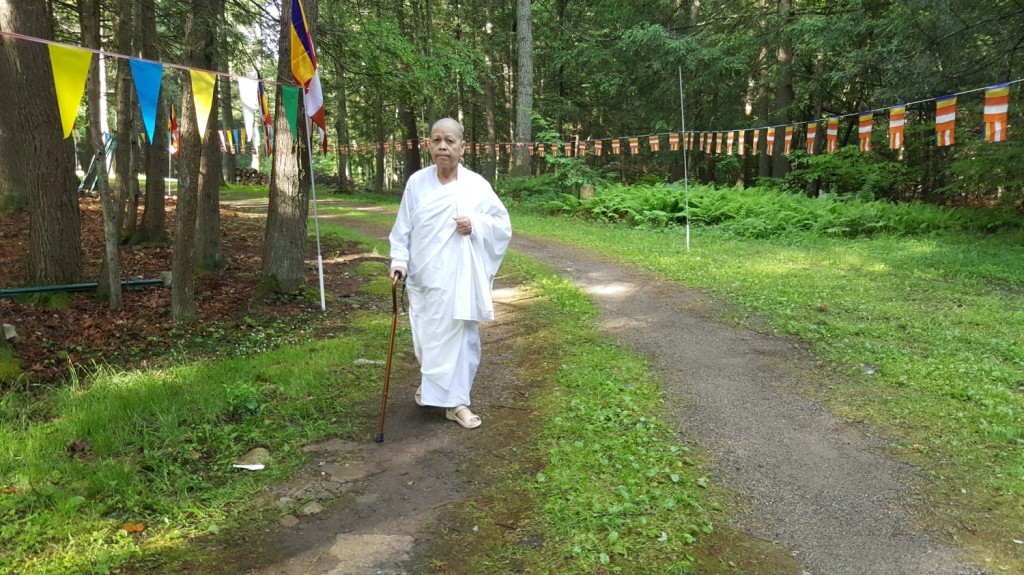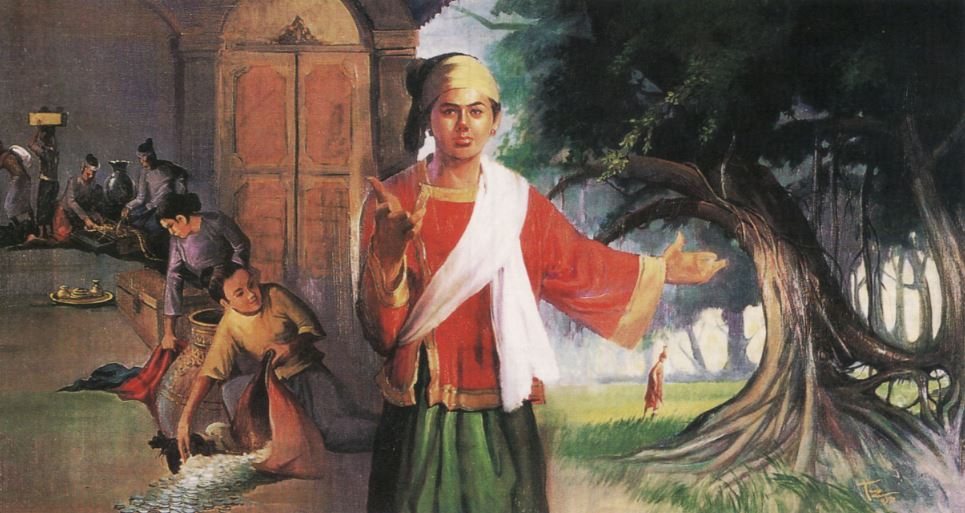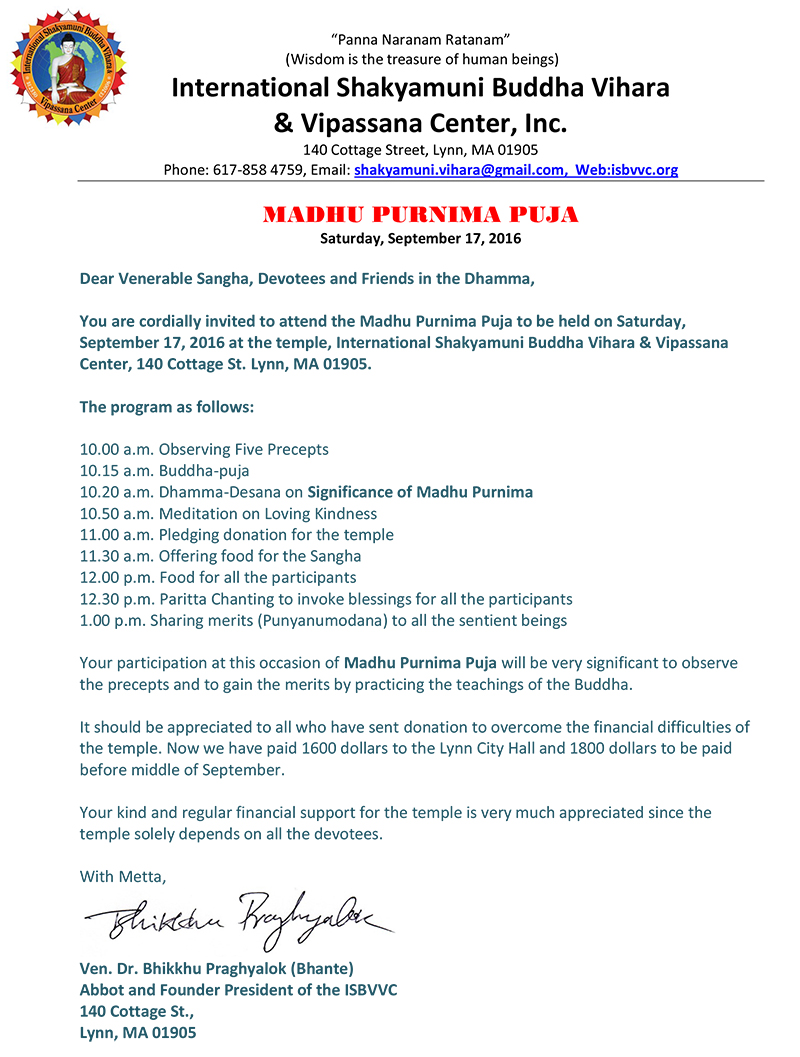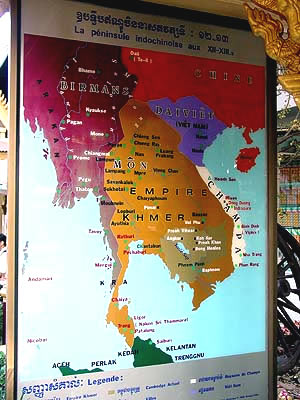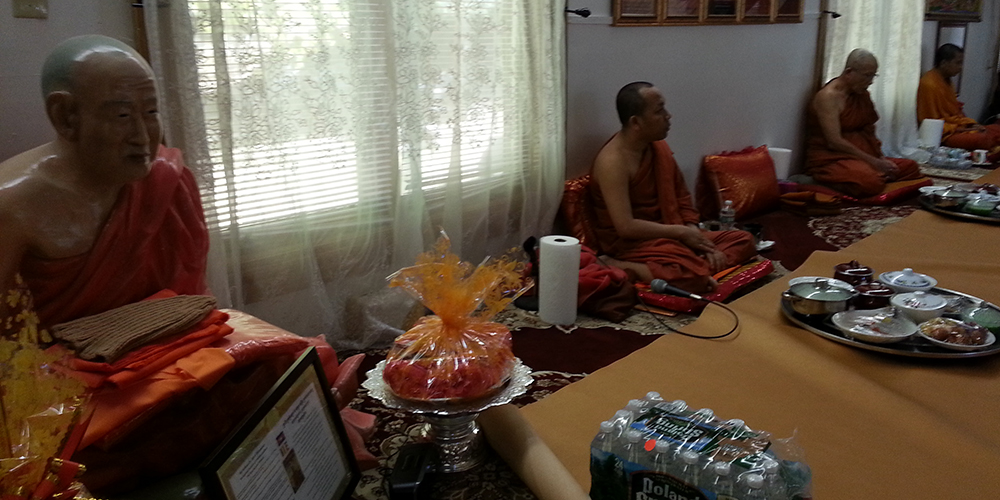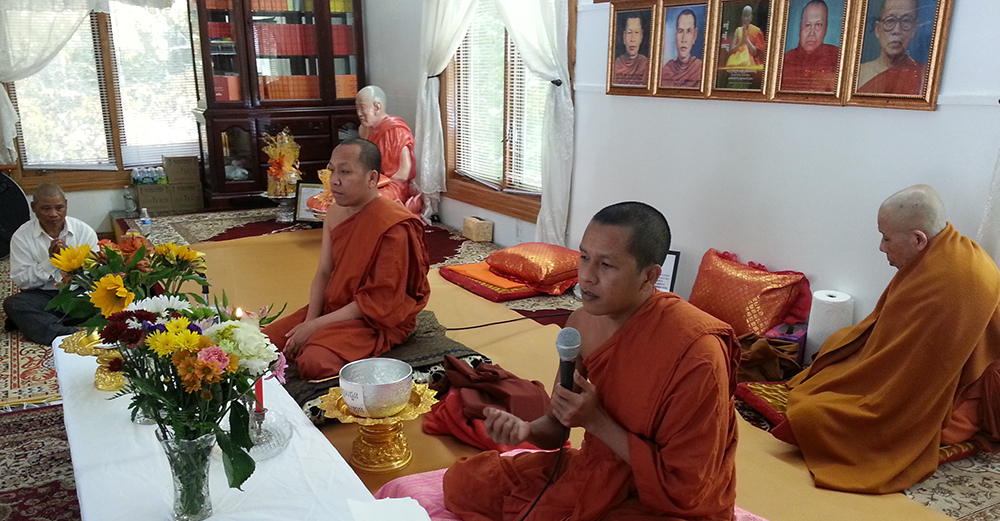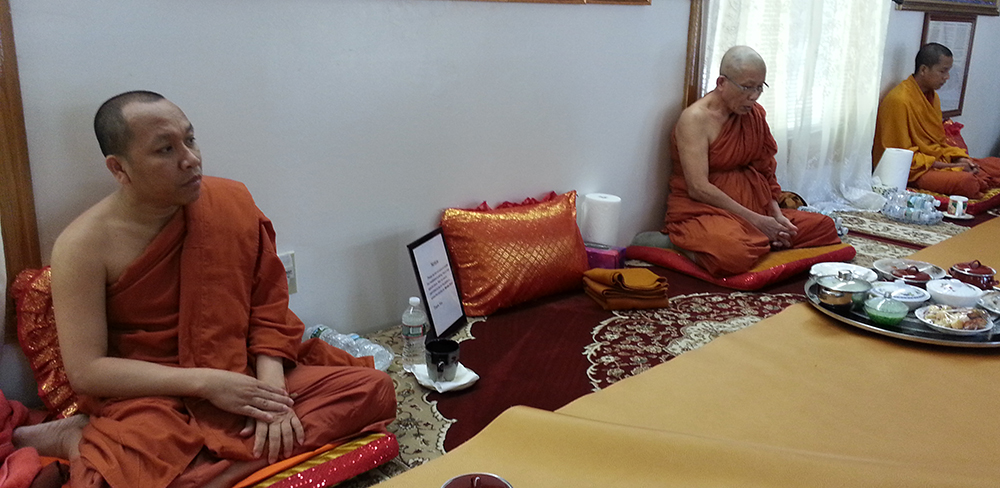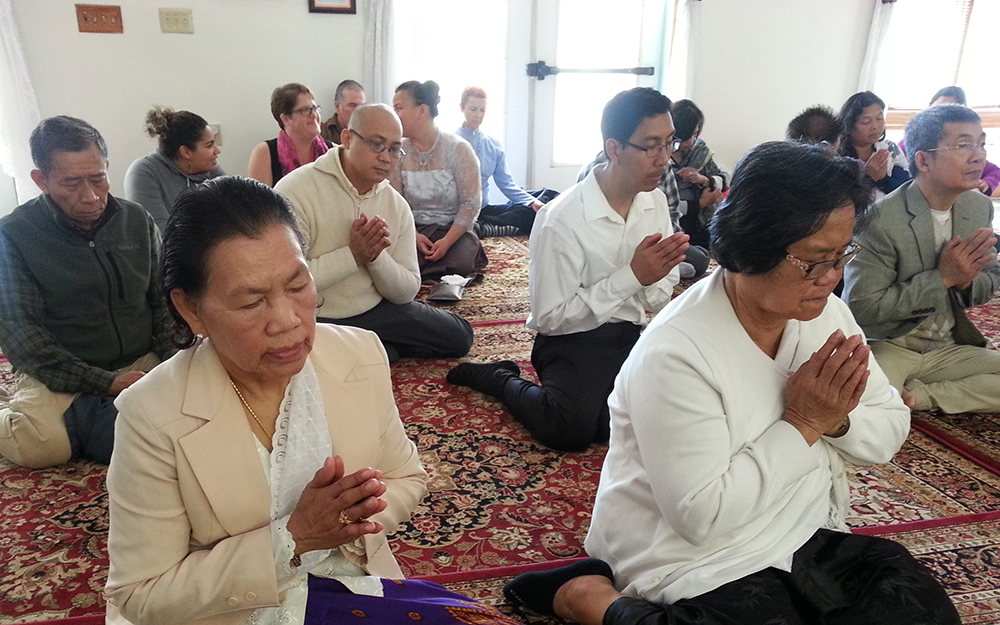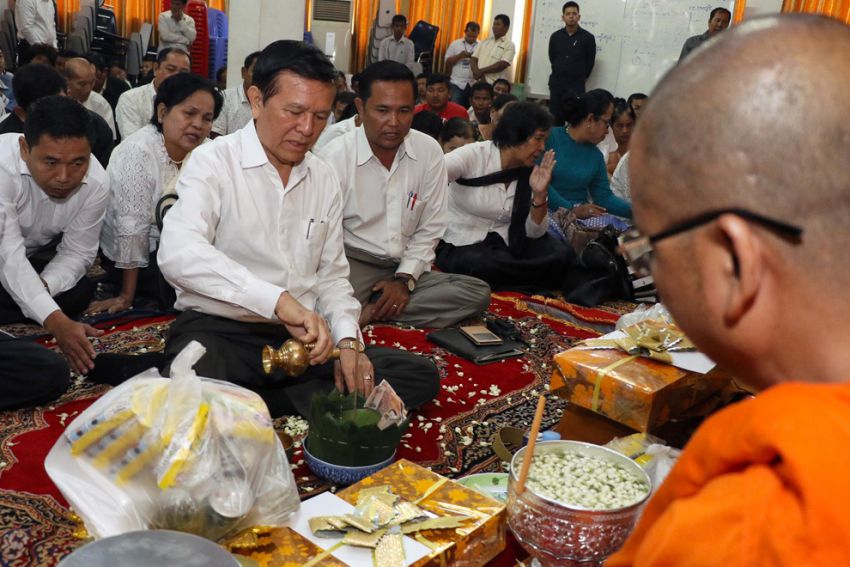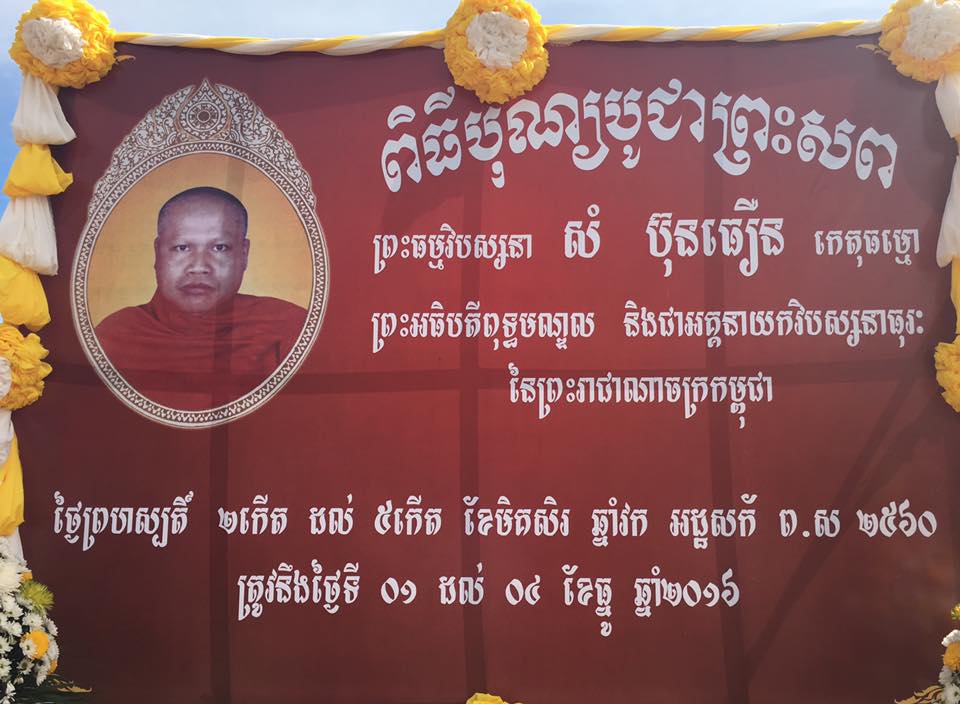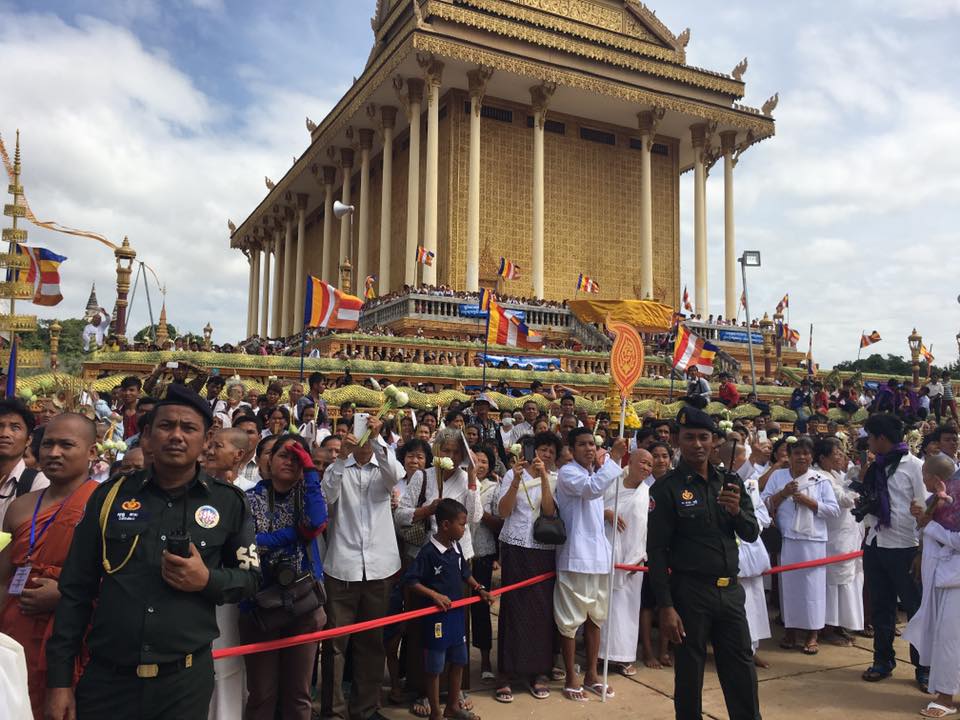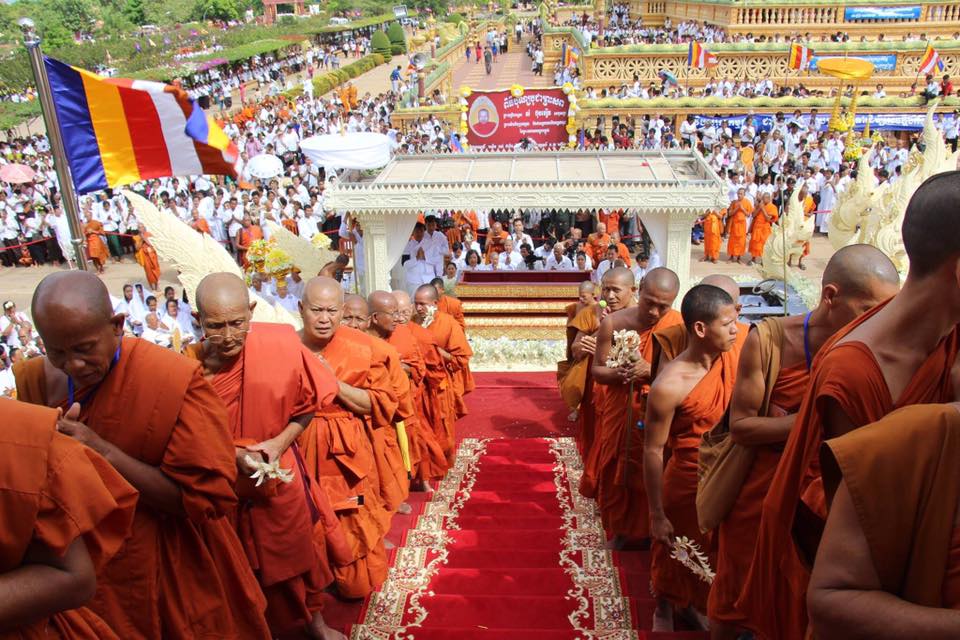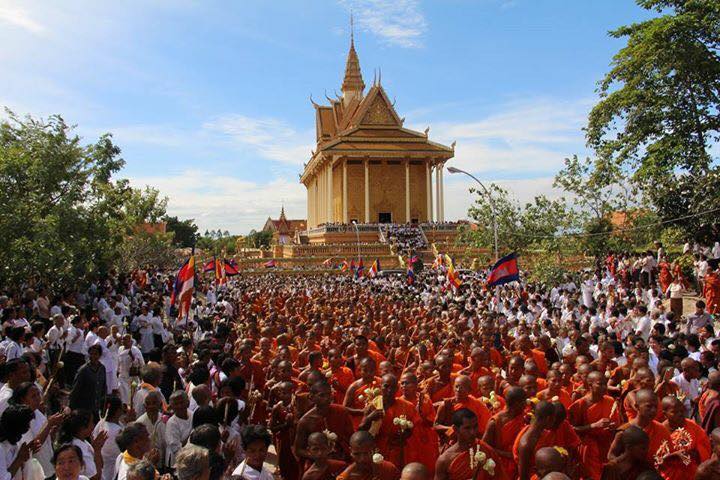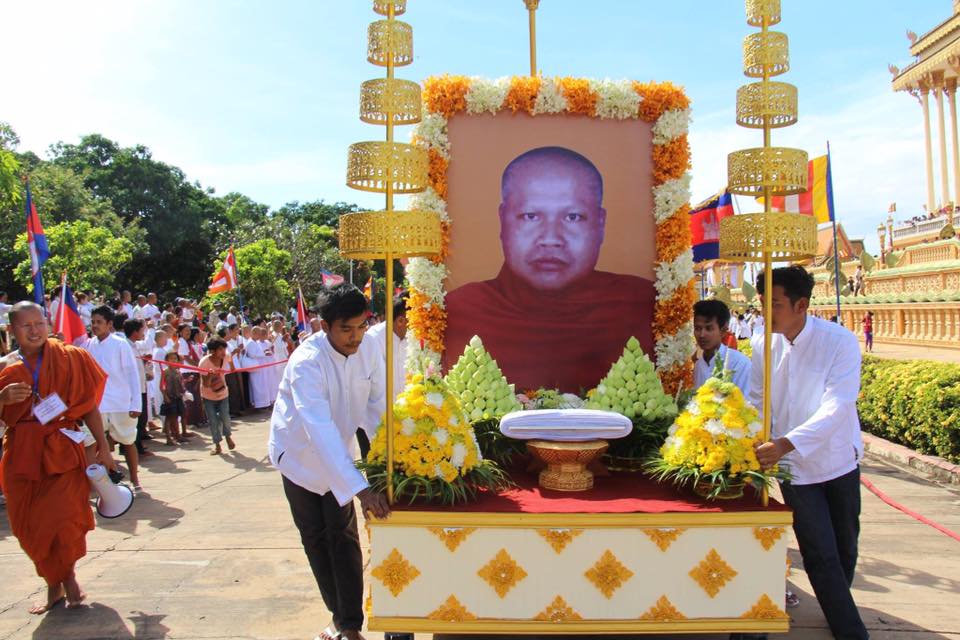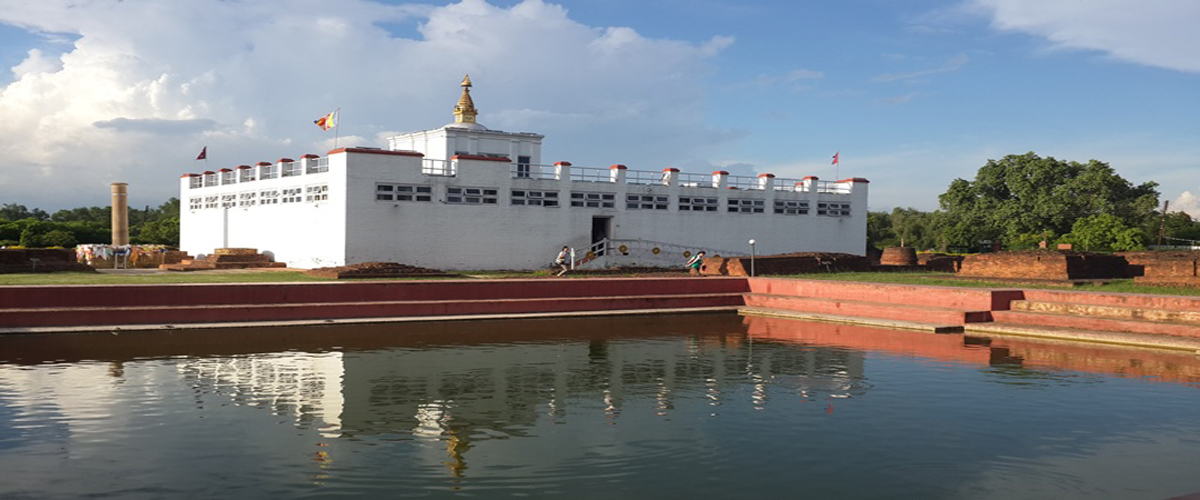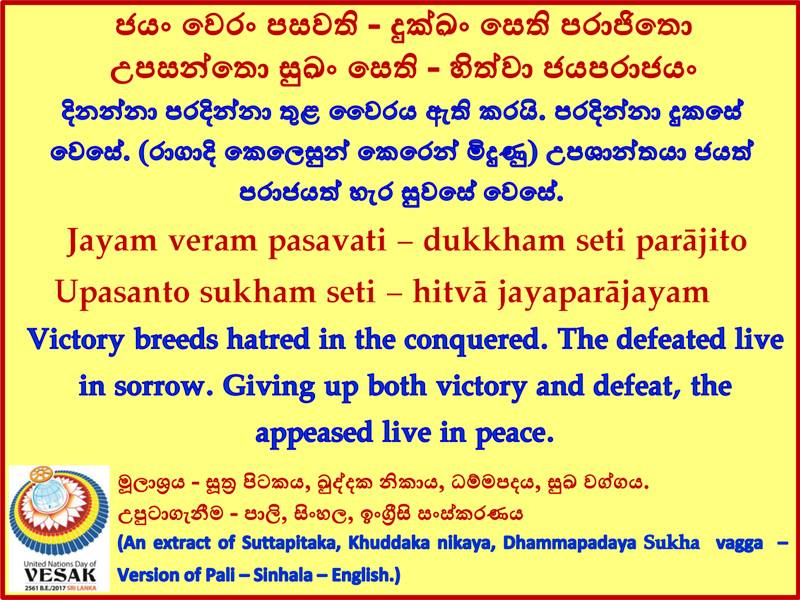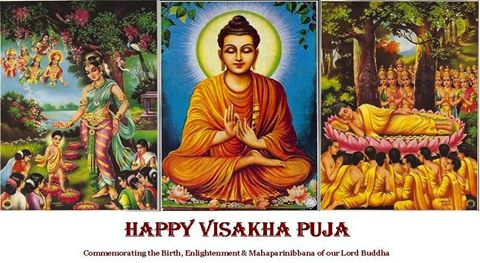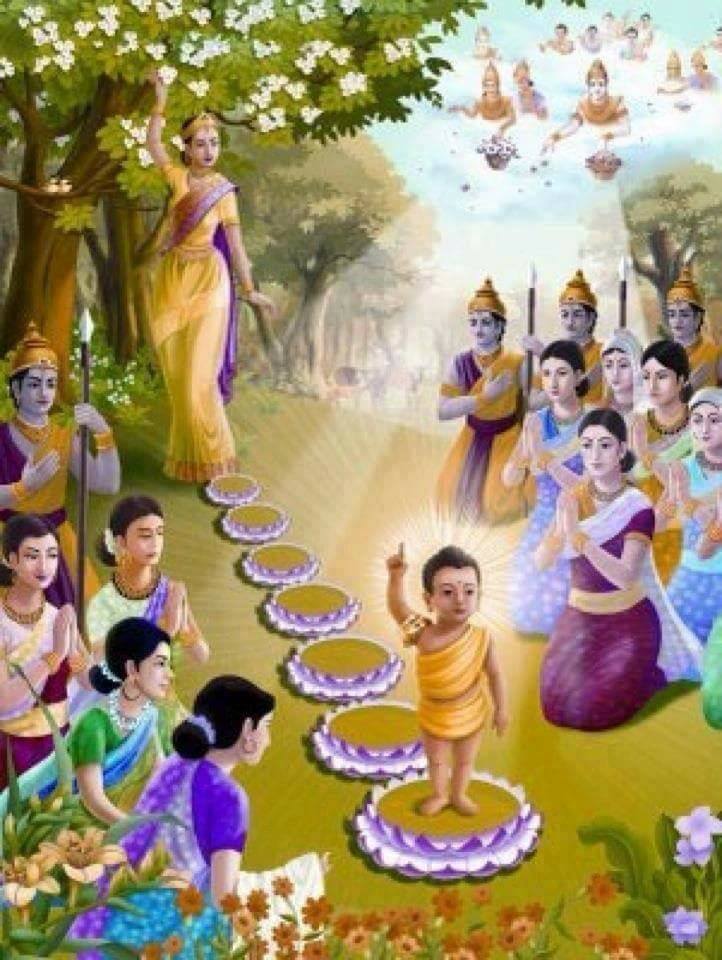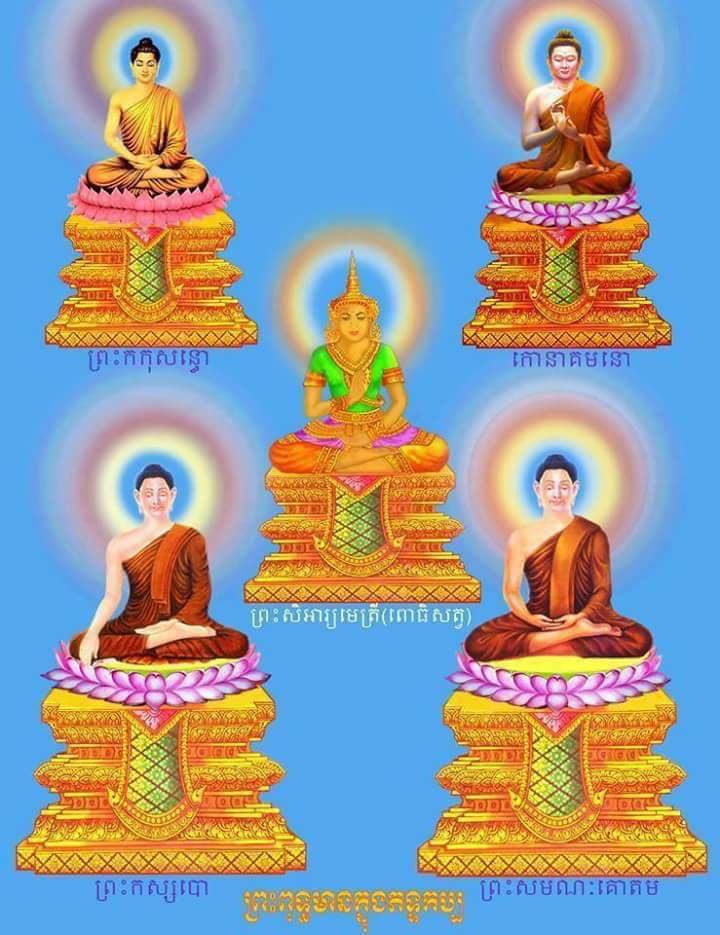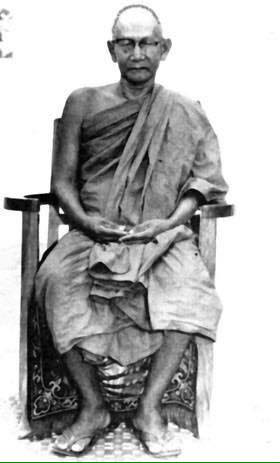The 5 Buddhas in this present Kalpa called bhadrakalpa (Auspicious aeon).
Background on each Buddha (Source Wikipedia)
Kakusandha Buddha
(Pāli), known as Krakucchaṃda in Sanskrit, and Khorvadjig in Tibetan) is one of the ancient Buddhas whose biography is chronicled in chapter 22 of the Buddhavamsa, one of the books of the Pāli Canon.
According to Theravāda Buddhist tradition, Kakusandha is the twenty-fifth of the twenty-nine named Buddhas, the fourth of the Seven Buddhas of Antiquity, and the first of the five Buddhas of the present kalpa.
The present kalpa is called the bhadrakalpa (Auspicious aeon). The five Buddhas of the present kalpa are:
Kakusandha (the first Buddha of the bhadrakalpa)
Koṇāgamana (the second Buddha of the bhadrakalpa)
Kassapa (the third Buddha of the bhadrakalpa)
Gautama (the fourth and present Buddha of the bhadrakalpa)
Maitreya (the fifth and future Buddha of the bhadrakalpa)
Life
Kakusandha Buddha was born in Khemavati Park in Khemavati. Khemavati is now known as Gotihawa, and it is located about 4 kilometres (2.5 mi) southeast of Kapilavastu, in Kapilvastu District, in the Lumbini Zone of southern Nepal. His father was Aggidatta, a Brahmin chaplain of the king Khemankara of Khemavati. His mother was Visakha. His wife was Virochamana (also known as Rocani); he had a son, Uttara (son of Kakusandha). Asoka visited Gotihawa, Nepal when he visited Lumbini, Nepal and installed a stone pillar and inscribed his visit in the pillar. There is also a stupa in Gothihawa. Therefore, it is generally accepted due to the pillar that the birthplace of Kakusandha is in Gothihawa, Nepal near Kapilavastu Municipality, Lumbini, Devadaha and the Ramagrama stupa.
Kakusandha lived for four thousand years in the household in three palaces: Ruci, Suruci and Vaddhana (or Rativaddhana). At the age of four thousand, he renounced the worldly life while riding on a chariot. He practised austerities for eight months.[6] Before attaining enlightenment, he had accepted some milk-rice from the daughter of the Brahmin Vajirindha of the village Suchirindha, as well as grass for his seat from the yavapalaka Subhadda. He attained enlightenment under a sirisa tree, then delivered his first sermon to the assembly of eighty-four thousand monks in a park near Makila.
Kakusandha performed the twin miracle under a sala tree, at the gates of Kannakujja. Among his converts was a fierce yaksha named Naradeva. Kakusandha kept the fast-day (uposatha) every year.
His chief disciples were Vidhura and Sanjiva among the monks, and Sama and Champa among the nuns. His personal attendant was Buddhija. Acchuta and Samana among the men, and Nanda and Sunanda among the women were his chief lay-supporters. Acchuta built a monastery for Kakusandha Buddha on the same site, which was later chosen by Anathapindika for Jetavana Arama for Gautama Buddha.
According to the Samyutta Nikaya (ii.194), the Vepulla peak of Rajgir was then called Pachinvamsa; and the people of the region Tivara.
Kakusandha’s body was forty cubits in height, and he died at the age of forty thousand years in Khemavati. The stupa erected over his relics was one league high.[6]
The bodhisattva who was to become Siddhartha Gautama was born as King Khema during the time of Kakusandha. Kakusandha was the Buddha who foretold that King Khema, who offered him alms with robes and medicines, would become the Gautama Buddha in the future.
Koṇāgamana Buddha
(Pāli), known as Kanakamuni in Sanskrit, also known as Koṇāgon or Kanakagamana, is one of the ancient Buddhas whose biography is chronicled in chapter 23 of the Buddhavamsa, one of the books of the Pāli Canon.
According to Theravāda Buddhist tradition, Koṇāgamana is the twenty-sixth of the twenty-nine named Buddhas, the fifth of the Seven Buddhas of Antiquity, and the second of the five Buddhas of the present kalpa.
The present kalpa is called the bhadrakalpa (Auspicious aeon). The five Buddhas of the present kalpa are:[3][4]
Kakusandha (the first Buddha of the bhadrakalpa)
Koṇāgamana (the second Buddha of the bhadrakalpa)
Kassapa (the third Buddha of the bhadrakalpa)
Gautama (the fourth and present Buddha of the bhadrakalpa)
Maitreya (the fifth and future Buddha of the bhadrakalpa)
Koṇāgamana was born in Subhagavati Park in Sobhavati[1] (now known as Araurakot, located about 3 kilometres (1.9 mi) southwest of Nigalihawa) on Wednesday;[5] because of this Koṇāgamana is placed on the Wednesday pedestal.
According to Xuanzang, Koṇāgamana’s relics were held in a stupa in Nigalisagar, in what is now Kapilvastu District in southern Nepal. There is an Ashoka pillar at the site today. Ashoka’s inscription in Brahmi is on the fragment of the pillar still partly buried in the ground.
Kassapa Buddha
(Pāli), known as Kāśyapa in Sanskrit, is one of the ancient Buddhas whose biography is chronicled in chapter 24 of the Buddhavamsa, one of the books of the Pāli Canon.
According to Theravāda Buddhist tradition, Kassapa is the twenty-seventh of the twenty-nine named Buddhas, the sixth of the Seven Buddhas of Antiquity, and the third of the five Buddhas of the present kalpa.
The present kalpa is called the bhadrakalpa (Auspicious aeon). The five Buddhas of the present kalpa are:
Kakusandha (the first Buddha of the bhadrakalpa)
Koṇāgamana (the second Buddha of the bhadrakalpa)
Kassapa (the third Buddha of the bhadrakalpa)
Gautama (the fourth and present Buddha of the bhadrakalpa)
Maitreya (the fifth and future Buddha of the bhadrakalpa)
Kassapa was born in Isipatana Deer Park. This place is located in Varanasi, a city in the modern-day state of Uttar Pradesh in northern India. His parents were the Brahmins Brahmadatta and Dhanavatī, of the Kashyap Gotra.
According to legend, his body was twenty cubits high, and he lived for two thousand years in three different palaces. They are Hamsa, Yasa, and Sirinanda. (The BuA.217 calls the first two palaces Hamsavā and Yasavā). His chief wife was Sunandā, who bore him a son named Vijitasena.
Kassapa gave up his worldly life traveling in his palace.[further explanation needed] He practiced austerities for only seven days. Just before attaining enlightenment, he accepted a meal of milk-rice from his wife and grass for his seat from a yavapālaka named Soma. His Bodhi tree (the tree under which he attained enlightenment) was a banyan, and he preached his first sermon at Isipatana to an assembly of monks who had renounced the world in his company.
Kassapa performed the Twin Miracle at the foot of an asana tree outside Sundar Nagar. He held only one assembly of his disciples; among his most famous conversions was that of Nāradeva, a Yaksha. His chief disciples among monks were Tissa and Bhāradvāja, and among nuns were Anulā and Uruvelā, his constant attendant being Sabbamitta. Among his patrons, the most eminent were Sumangala and Ghattīkāra, Vijitasenā, and Bhaddā.
Kassapa died at the age of forty thousand years, in the city of Kashi, in the Kashi Kingdom (now known as Varanasi, in the modern-day Indian state of Uttar Pradesh). Over his relics was raised a stupa one league in height, each brick of which was worth one crore (ten million) rupees.
The Stupa of Kassapa Buddha
There was initially a great difference of opinion on what should be the size of the stupa and of what material it should be built. Construction of the stupa was begun after these issues were finally settled. But then the citizens found they lacked sufficient funds to complete the stupa. An anāgāmi devotee named Sorata travelled throughout Jambudvipa, requesting money from the people for the completion of the stupa. He sent the money as he received it, and on hearing that the work was completed, he set out to go and worship the stupa. However, he was seized by robbers and murdered in the forest, which later came to be known as the Andhavana.
Upavāna, in a previous birth, became the guardian deity of the stupa, hence his great majesty in his last life (DA.ii.580; for another story of the building of the shrine see DhA.iii.29).
Among the thirty-seven goddesses noticed by Guttila when he visited heaven was one who had offered a scented five-spray at the stupa (J.ii.256). Alāta offered āneja-flowers and obtained a happy rebirth (J.vi.227).
The cause of Mahākāśyapa’s golden complexion was his gift of a golden brick to the building of Kassapa’s shrine (AA.i.116).
At the same stupa, Anuruddha, who was then a householder in Varanasi, offered butter and molasses in brass bowls, which were placed without any interval around the stupa (AA.i.105).
Gautama Buddha
(c. 563 BCE/480 BCE – c. 483 BCE/400 BCE), also known as Siddhārtha Gautama [sid̪ːʱɑːrt̪ʰə gəut̪əmə], Shakyamuni Buddha [ɕɑːkjəmun̪i bud̪ːʱə], or simply the Buddha, after the title of Buddha, was an ascetic (śramaṇa) and sage, on whose teachings Buddhism was founded.[5] He is believed to have lived and taught mostly in the eastern part of ancient India sometime between the sixth and fourth centuries BCE.
Gautama taught a Middle Way between sensual indulgence and the severe asceticism found in the śramaṇa movement common in his region. He later taught throughout other regions of eastern India such as Magadha and Kosala.
Gautama is the primary figure in Buddhism. He is recognized by Buddhists as an enlightened teacher who attained full Buddhahood, and shared his insights to help sentient beings end rebirth and suffering. Accounts of his life, discourses, and monastic rules are believed by Buddhists to have been summarized after his death and memorized by his followers. Various collections of teachings attributed to him were passed down by oral tradition and first committed to writing about 400 years later.
Ancient kingdoms and cities of India during the time of the Buddha.
Scholars are hesitant to make unqualified claims about the historical facts of the Buddha’s life. Most accept that he lived, taught and founded a monastic order during the Mahajanapada era during the reign of Bimbisara (c. 558 – c. 491 BCE, or c. 400 BCE),[9][10][11] the ruler of the Magadha empire, and died during the early years of the reign of Ajatasatru, who was the successor of Bimbisara, thus making him a younger contemporary of Mahavira, the Jain tirthankara.[12][13] Apart from the Vedic Brahmins, the Buddha’s lifetime coincided with the flourishing of influential Śramaṇa schools of thought like Ājīvika, Cārvāka, Jainism, and Ajñana.[14] Brahmajala Sutta records sixty-two such schools of thought. It was also the age of influential thinkers like Mahavira (referred to as ‘Nigantha Nataputta’ in Pali Canon),[15] Pūraṇa Kassapa, Makkhali Gosāla, Ajita Kesakambalī, Pakudha Kaccāyana, and Sañjaya Belaṭṭhaputta, as recorded in Samaññaphala Sutta, whose viewpoints the Buddha most certainly must have been acquainted with.[16][17][note 4] Indeed, Sariputta and Moggallāna, two of the foremost disciples of the Buddha, were formerly the foremost disciples of Sañjaya Belaṭṭhaputta, the skeptic;[19] and the Pali canon frequently depicts Buddha engaging in debate with the adherents of rival schools of thought. There is also philological evidence to suggest that the two masters, Alara Kalama and Uddaka Ramaputta, were indeed historical figures and they most probably taught Buddha two different forms of meditative techniques.[20] Thus, Buddha was just one of the many śramaṇa philosophers of that time.[21] In an era where holiness of person was judged by their level of asceticism[22], Buddha was a reformist within the śramaṇa movement, rather than a reactionary against Vedic Brahminism.[23] While the general sequence of “birth, maturity, renunciation, search, awakening and liberation, teaching, death” is widely accepted,[24][page needed] there is less consensus on the veracity of many details contained in traditional biographies.[25][26]
The times of Gautama’s birth and death are uncertain. Most historians in the early 20th century dated his lifetime as circa 563 BCE to 483 BCE.[1][27] More recently his death is dated later, between 411 and 400 BCE, while at a symposium on this question held in 1988,[28][29][30] the majority of those who presented definite opinions gave dates within 20 years either side of 400 BCE for the Buddha’s death.[1][31][note 3] These alternative chronologies, however, have not yet been accepted by all historians.[36][37][note 5]
The evidence of the early texts suggests that Siddhārtha Gautama was born into the Shakya clan, a community that was on the periphery, both geographically and culturally, of the eastern Indian subcontinent in the 5th century BCE.[42] It was either a small republic, or an oligarchy, and his father was an elected chieftain, or oligarch.[42] According to the Buddhist tradition, Gautama was born in Lumbini, now in modern-day Nepal, and raised in the Shakya capital of Kapilvastu, which may have been either in what is present day Tilaurakot, Nepal or Piprahwa, India.[note 1] He obtained his enlightenment in Bodh Gaya, gave his first sermon in Sarnath, and died in Kushinagar.
No written records about Gautama were found from his lifetime or some centuries thereafter. One Edict of Asoka, who reigned from circa 269 BCE to 232 BCE, commemorates the Emperor’s pilgrimage to the Buddha’s birthplace in Lumbini. Another one of his edicts mentions the titles of several Dhamma texts, establishing the existence of a written Buddhist tradition at least by the time of the Maurya era. These texts may be the precursor of the Pāli Canon.[59][60] [note 7] The oldest surviving Buddhist manuscripts are the Gandhāran Buddhist texts, reported to have been found in or around Haḍḍa near Jalalabad in eastern Afghanistan and now preserved in the British Library. They are written in the Gāndhārī language using the Kharosthi script on twenty-seven birch bark manuscripts and date from the first century BCE to the third century CE.[61]
On the basis of philological evidence, Indologist and Pali expert Oskar von Hinüber says that some of the Pali suttas have retained very archaic place-names and historical data from close to the Buddha’s lifetime, including the Mahāparinibbāṇa Sutta which contains a detailed account of the Buddha’s final days. Hinüber proposes a composition date of no later than 350-320 BCE for this text, which would allow for a “true historical memory” of the events approximately 60 years prior if the Short Chronology for the Buddha’s lifetime is accepted (but also reminds that such a text was originally intended more as hagiography than as an exact historical record of events).[62][63]
Traditional biographies
Buddha by Otgonbayar Ershuu
Biographical sources
The sources for the life of Siddhārtha Gautama are a variety of different, and sometimes conflicting, traditional biographies. These include the Buddhacarita, Lalitavistara Sūtra, Mahāvastu, and the Nidānakathā.[64] Of these, the Buddhacarita[65][66][67] is the earliest full biography, an epic poem written by the poet Aśvaghoṣa in the first century CE.[68] The Lalitavistara Sūtra is the next oldest biography, a Mahāyāna/Sarvāstivāda biography dating to the 3rd century CE.[69] The Mahāvastu from the Mahāsāṃghika Lokottaravāda tradition is another major biography, composed incrementally until perhaps the 4th century CE.[69] The Dharmaguptaka biography of the Buddha is the most exhaustive, and is entitled the Abhiniṣkramaṇa Sūtra,[70] and various Chinese translations of this date between the 3rd and 6th century CE. The Nidānakathā is from the Theravada tradition in Sri Lanka and was composed in the 5th century by Buddhaghoṣa.[71]
From canonical sources come the Jataka tales, the Mahapadana Sutta (DN 14), and the Achariyabhuta Sutta (MN 123), which include selective accounts that may be older, but are not full biographies. The Jātakas retell previous lives of Gautama as a bodhisattva, and the first collection of these can be dated among the earliest Buddhist texts.[72] The Mahāpadāna Sutta and Achariyabhuta Sutta both recount miraculous events surrounding Gautama’s birth, such as the bodhisattva’s descent from the Tuṣita Heaven into his mother’s womb.
Nature of traditional depictions
Māyā miraculously giving birth to Siddhārtha. Sanskrit, palm-leaf manuscript. Nālandā, Bihar, India. Pāla period
In the earliest Buddhist texts, the nikāyas and āgamas, the Buddha is not depicted as possessing omniscience (sabbaññu)[73] nor is he depicted as being an eternal transcendent (lokottara) being. According to Bhikkhu Analayo, ideas of the Buddha’s omniscience (along with an increasing tendency to deify him and his biography) are found only later, in the Mahayana sutras and later Pali commentaries or texts such as the Mahāvastu.[73] In the Sandaka Sutta, the Buddha’s disciple Ananda outlines an argument against the claims of teachers who say they are all knowing [74] while in the Tevijjavacchagotta Sutta the Buddha himself states that he has never made a claim to being omniscient, instead he claimed to have the “higher knowledges” (abhijñā).[75] The earliest biographical material from the Pali Nikayas focuses on the Buddha’s life as a śramaṇa, his search for enlightenment under various teachers such as Alara Kalama and his forty-five-year career as a teacher.[76]
Traditional biographies of Gautama generally include numerous miracles, omens, and supernatural events. The character of the Buddha in these traditional biographies is often that of a fully transcendent (Skt. lokottara) and perfected being who is unencumbered by the mundane world. In the Mahāvastu, over the course of many lives, Gautama is said to have developed supramundane abilities including: a painless birth conceived without intercourse; no need for sleep, food, medicine, or bathing, although engaging in such “in conformity with the world”; omniscience, and the ability to “suppress karma”.[77] Nevertheless, some of the more ordinary details of his life have been gathered from these traditional sources. In modern times there has been an attempt to form a secular understanding of Siddhārtha Gautama’s life by omitting the traditional supernatural elements of his early biographies.
Andrew Skilton writes that the Buddha was never historically regarded by Buddhist traditions as being merely human:
It is important to stress that, despite modern Theravada teachings to the contrary (often a sop to skeptical Western pupils), he was never seen as being merely human. For instance, he is often described as having the thirty-two major and eighty minor marks or signs of a mahāpuruṣa, “superman”; the Buddha himself denied that he was either a man or a god; and in the Mahāparinibbāna Sutta he states that he could live for an aeon were he asked to do so.[78]
The ancient Indians were generally unconcerned with chronologies, being more focused on philosophy. Buddhist texts reflect this tendency, providing a clearer picture of what Gautama may have taught than of the dates of the events in his life. These texts contain descriptions of the culture and daily life of ancient India which can be corroborated from the Jain scriptures, and make the Buddha’s time the earliest period in Indian history for which significant accounts exist.[79] British author Karen Armstrong writes that although there is very little information that can be considered historically sound, we can be reasonably confident that Siddhārtha Gautama did exist as a historical figure.[80] Michael Carrithers goes a bit further by stating that the most general outline of “birth, maturity, renunciation, search, awakening and liberation, teaching, death” must be true.[24]
Biography
Conception and birth
Maya’s dream of the Birth of Gautama Siddharta
Birthplace of Gautama Buddha in Lumbini, Nepal,[note 1][81] a holy shrine also for many non-Buddhists.[note 8]
The Buddhist tradition regards Lumbini, in present-day Nepal to be the birthplace of the Buddha.[82][note 1] He grew up in Kapilavastu.[note 1] The exact site of ancient Kapilavastu is unknown.[83] It may have been either Piprahwa, Uttar Pradesh, in present-day India,[54] or Tilaurakot, in present-day Nepal.[84] Both places belonged to the Sakya territory, and are located only 15 miles apart.[84]
Gautama was born as a Kshatriya,[85][note 9] the son of Śuddhodana, “an elected chief of the Shakya clan”,[6] whose capital was Kapilavastu, and who were later annexed by the growing Kingdom of Kosala during the Buddha’s lifetime. Gautama was the family name. His mother, Maya (Māyādevī), Suddhodana’s wife, was a Koliyan princess. Legend has it that, on the night Siddhartha was conceived, Queen Maya dreamt that a white elephant with six white tusks entered her right side,[87][88] and ten months later[89] Siddhartha was born. As was the Shakya tradition, when his mother Queen Maya became pregnant, she left Kapilavastu for her father’s kingdom to give birth. However, her son is said to have been born on the way, at Lumbini, in a garden beneath a sal tree.
The day of the Buddha’s birth is widely celebrated in Theravada countries as Vesak.[90] Buddha’s Birthday is called Buddha Purnima in Nepal, Bangladesh, and India as he is believed to have been born on a full moon day. Various sources hold that the Buddha’s mother died at his birth, a few days or seven days later. The infant was given the name Siddhartha (Pāli: Siddhattha), meaning “he who achieves his aim”. During the birth celebrations, the hermit seer Asita journeyed from his mountain abode and announced that the child would either become a great king (chakravartin) or a great sadhu.[91] By traditional account,[which?] this occurred after Siddhartha placed his feet in Asita’s hair and Asita examined the birthmarks. Suddhodana held a naming ceremony on the fifth day, and invited eight Brahmin scholars to read the future. All gave a dual prediction that the baby would either become a great king or a great holy man.[91] Kondañña, the youngest, and later to be the first arhat other than the Buddha, was reputed to be the only one who unequivocally predicted that Siddhartha would become a Buddha.[92]
While later tradition and legend characterized Śuddhodana as a hereditary monarch, the descendant of the Suryavansha (Solar dynasty) of Ikṣvāku (Pāli: Okkāka), many scholars think that Śuddhodana was the elected chief of a tribal confederacy.
Early texts suggest that Gautama was not familiar with the dominant religious teachings of his time until he left on his religious quest, which is said to have been motivated by existential concern for the human condition.[93] The state of the Shakya clan was not a monarchy and seems to have been structured either as an oligarchy, or as a form of republic.[94] The more egalitarian gana-sangha form of government, as a political alternative to the strongly hierarchical kingdoms, may have influenced the development of the śramanic Jain and Buddhist sanghas, where monarchies tended toward Vedic Brahmanism.[95]
Birth and childhood of the Buddha
Maya’s dream, Bharhut, circa 150 BCE.
Maya’s dream, Gandhara, 2nd century CE.
Birth of the Buddha.
The Infant Buddha Taking A Bath, Gandhara 2nd Century CE.
The infant Buddha taking the Seven Steps. Greco-Buddhist art of Gandhara.
Early life and marriage
Departure of Prince Siddhartha
Siddhartha was brought up by his mother’s younger sister, Maha Pajapati.[96] By tradition, he is said to have been destined by birth to the life of a prince and had three palaces (for seasonal occupation) built for him. His father, said to be King Śuddhodana, wishing for his son to be a great king, is said to have shielded him from religious teachings and from knowledge of human suffering. While Śuddhodana has traditionally been depicted as a king, and Siddhartha as his prince, more recent scholarship suggests the Shakya were in-fact organized as a semi-republican oligarchy rather than a monarchy. [97]
When he reached the age of 16, his father reputedly arranged his marriage to a cousin of the same age named Yaśodharā (Pāli: Yasodharā). According to the traditional account,[which?] she gave birth to a son, named Rāhula. Siddhartha is said to have spent 29 years as a prince in Kapilavastu. Although his father ensured that Siddhartha was provided with everything he could want or need, Buddhist scriptures say that the future Buddha felt that material wealth was not life’s ultimate goal.[96]
Renunciation and ascetic life
The Victory of Buddha
The “Great Departure” of Siddhartha Gautama, surrounded by a halo, he is accompanied by numerous guards, maithuna loving couples, and devata who have come to pay homage; Gandhara, Kushan period
Prince Siddhartha shaves his hair and becomes an ascetic. Borobudur, 8th century
At the age of 29, Siddhartha left his palace to meet his subjects. Despite his father’s efforts to hide from him the sick, aged and suffering, Siddhartha was said to have seen an old man. When his charioteer Channa explained to him that all people grew old, the prince went on further trips beyond the palace. On these he encountered a diseased man, a decaying corpse, and an ascetic. These depressed him, and he initially strove to overcome ageing, sickness, and death by living the life of an ascetic.[98]
Accompanied by Channa and riding his horse Kanthaka, Gautama quit his palace for the life of a mendicant. It’s said that “the horse’s hooves were muffled by the gods”[99] to prevent guards from knowing of his departure.
Gautama initially went to Rajagaha and began his ascetic life by begging for alms in the street. After King Bimbisara’s men recognised Siddhartha and the king learned of his quest, Bimbisara offered Siddhartha the throne. Siddhartha rejected the offer but promised to visit his kingdom of Magadha first, upon attaining enlightenment.
He left Rajagaha and practised under two hermit teachers of yogic meditation.[100][101][102] After mastering the teachings of Alara Kalama (Skr. Ārāḍa Kālāma), he was asked by Kalama to succeed him. However, Gautama felt unsatisfied by the practice, and moved on to become a student of yoga with Udaka Ramaputta (Skr. Udraka Rāmaputra).[103] With him he achieved high levels of meditative consciousness and was again asked to succeed his teacher. But, once more, he was not satisfied, and again moved on.[104]
Awakening
The Buddha surrounded by the demons of Māra. Sanskrit palm leaf manuscript. Nālandā, Bihar, India. Pāla period
See also: Enlightenment in Buddhism
stone Mahabodhi temple in Bodh Gaya, India, is the place where Gautama Buddha attained nirvana underneath the Bodhi Tree
Mahabodhi Temple in Bodh Gaya, India, where Gautama Buddha attained nirvana under the Bodhi Tree (left)
Main articles: Moksha and Nirvana (Buddhism)
According to the early Buddhist texts,[105] after realizing that meditative dhyana was the right path to awakening, but that extreme asceticism didn’t work, Gautama discovered what Buddhists know as being, the Middle Way[105]—a path of moderation away from the extremes of self-indulgence and self-mortification, or the Noble Eightfold Path, as described in the Dhammacakkappavattana Sutta, which is regarded as the first discourse of the Buddha.[105] In a famous incident, after becoming starved and weakened, he is said to have accepted milk and rice pudding from a village girl named Sujata.[106] Such was his emaciated appearance that she wrongly believed him to be a spirit that had granted her a wish.[106]
Following this incident, Gautama was famously seated under a pipal tree—now known as the Bodhi tree—in Bodh Gaya, India, when he vowed never to arise until he had found the truth.[107] Kaundinya and four other companions, believing that he had abandoned his search and become undisciplined, ceased to stay with him, and went to somewhere else. After a reputed 49 days of meditation, at the age of 35, he is said to have attained Enlightenment,[107][108] and became known as the Buddha or “Awakened One” (“Buddha” is also sometimes translated as “The Enlightened One”).
According to some sutras of the Pali canon, at the time of his awakening he realized complete insight into the Four Noble Truths, thereby attaining liberation from samsara, the endless cycle of rebirth, suffering and dying again.[109][110][111] According to scholars, this story of the awakening and the stress on “liberating insight” is a later development in the Buddhist tradition, where the Buddha may have regarded the practice of dhyana as leading to Nirvana and moksha.
Nirvana is the extinguishing of the “fires” of desire, hatred, and ignorance, that keep the cycle of suffering and rebirth going.[114] Nirvana is also regarded as the “end of the world”, in that no personal identity or boundaries of the mind remain.[citation needed] In such a state, a being is said to possess the Ten Characteristics, belonging to every Buddha.
According to a story in the Āyācana Sutta (Samyutta Nikaya VI.1) — a scripture found in the Pāli and other canons — immediately after his awakening, the Buddha debated whether or not he should teach the Dharma to others. He was concerned that humans were so overpowered by ignorance, greed and hatred that they could never recognise the path, which is subtle, deep and hard to grasp. However, in the story, Brahmā Sahampati convinced him, arguing that at least some will understand it. The Buddha relented, and agreed to teach.
Formation of the sangha
Dhamek Stupa in Sarnath, India, site of the first teaching of the Buddha in which he taught the Four Noble Truths to his first five disciples
Mulagandhakuti, Remains of Buddha’s hut in Jetavana Monastery, Shravasti, India, Where the Buddha delivered majority of his discourses[115]
After his awakening, the Buddha met Taphussa and Bhallika — two merchant brothers from the city of Balkh in what is currently Afghanistan — who became his first lay disciples. It is said that each was given hairs from his head, which are now claimed to be enshrined as relics in the Shwe Dagon Temple in Rangoon, Burma. The Buddha intended to visit Asita, and his former teachers, Alara Kalama and Udaka Ramaputta, to explain his findings, but they had already died.
He then travelled to the Deer Park near Varanasi (Benares) in northern India, where he set in motion what Buddhists call the Wheel of Dharma by delivering his first sermon to the five companions with whom he had sought enlightenment. Together with him, they formed the first saṅgha: the company of Buddhist monks.
All five become arahants, and within the first two months, with the conversion of Yasa and fifty-four of his friends, the number of such arahants is said to have grown to 60. The conversion of three brothers named Kassapa followed, with their reputed 200, 300 and 500 disciples, respectively. This swelled the sangha to more than 1,000.
Travels and teaching
Buddha with his protector Vajrapani, Gandhāra, 2nd century CE, Ostasiatische Kunst Museum
For the remaining 45 years of his life, the Buddha is said to have traveled in the Gangetic Plain, in what is now Uttar Pradesh, Bihar, and southern Nepal, teaching a diverse range of people: from nobles to servants, murderers such as Angulimala, and cannibals such as Alavaka.[116] Although the Buddha’s language remains unknown, it’s likely that he taught in one or more of a variety of closely related Middle Indo-Aryan dialects, of which Pali may be a standardization.
The sangha traveled through the subcontinent, expounding the dharma. This continued throughout the year, except during the four months of the Vassa rainy season when ascetics of all religions rarely traveled. One reason was that it was more difficult to do so without causing harm to animal life. At this time of year, the sangha would retreat to monasteries, public parks or forests, where people would come to them.
A view of Vulture Peak, Rajgir, India where the Atanatiya Sutta was held
The first vassana was spent at Varanasi when the sangha was formed. After this, the Buddha kept a promise to travel to Rajagaha, capital of Magadha, to visit King Bimbisara. During this visit, Sariputta and Maudgalyayana were converted by Assaji, one of the first five disciples, after which they were to become the Buddha’s two foremost followers. The Buddha spent the next three seasons at Veluvana Bamboo Grove monastery in Rajagaha, the capital of Magadha.
Upon hearing of his son’s awakening, Suddhodana sent, over a period, ten delegations to ask him to return to Kapilavastu. On the first nine occasions, the delegates failed to deliver the message and instead joined the sangha to become arahants. The tenth delegation, led by Kaludayi, a childhood friend of Gautama’s (who also became an arahant), however, delivered the message.
Now two years after his awakening, the Buddha agreed to return, and made a two-month journey by foot to Kapilavastu, teaching the dharma as he went. At his return, the royal palace prepared a midday meal, but the sangha was making an alms round in Kapilavastu. Hearing this, Suddhodana approached his son, the Buddha, saying:
“Ours is the warrior lineage of Mahamassata, and not a single warrior has gone seeking alms.”
The Buddha is said to have replied:
“That is not the custom of your royal lineage. But it is the custom of my Buddha lineage. Several thousands of Buddhas have gone by seeking alms.”
Buddhist texts say that Suddhodana invited the sangha into the palace for the meal, followed by a dharma talk. After this he is said to have become a sotapanna. During the visit, many members of the royal family joined the sangha. The Buddha’s cousins Ananda and Anuruddha became two of his five chief disciples. At the age of seven, his son Rahula also joined, and became one of his ten chief disciples. His half-brother Nanda also joined and became an arahant.
Of the Buddha’s disciples, Sariputta, Maudgalyayana, Mahakasyapa, Ananda and Anuruddha are believed to have been the five closest to him. His ten foremost disciples were reputedly completed by the quintet of Upali, Subhoti, Rahula, Mahakaccana and Punna.
In the fifth vassana, the Buddha was staying at Mahavana near Vesali when he heard news of the impending death of his father. He is said to have gone to Suddhodana and taught the dharma, after which his father became an arahant.
The last days of buddha teachings
The king’s death and cremation was to inspire the creation of an order of nuns. Buddhist texts record that the Buddha was reluctant to ordain women. His foster mother Maha Pajapati, for example, approached him, asking to join the sangha, but he refused. Maha Pajapati, however, was so intent on the path of awakening that she led a group of royal Sakyan and Koliyan ladies, which followed the sangha on a long journey to Rajagaha. In time, after Ananda championed their cause, the Buddha is said to have reconsidered and, five years after the formation of the sangha, agreed to the ordination of women as nuns. He reasoned that males and females had an equal capacity for awakening. But he gave women additional rules (Vinaya) to follow.
Mahaparinirvana
The Buddha’s entry into Parinirvana. Sanskrit palm leaf manuscript. Nālandā, Bihar, India. Pāla period
According to the Mahaparinibbana Sutta of the Pali canon, at the age of 80, the Buddha announced that he would soon reach Parinirvana, or the final deathless state, and abandon his earthly body. After this, the Buddha ate his last meal, which he had received as an offering from a blacksmith named Cunda. Falling violently ill, Buddha instructed his attendant Ānanda to convince Cunda that the meal eaten at his place had nothing to do with his passing and that his meal would be a source of the greatest merit as it provided the last meal for a Buddha.[117] Mettanando and von Hinüber argue that the Buddha died of mesenteric infarction, a symptom of old age, rather than food poisoning.[118][119]
The precise contents of the Buddha’s final meal are not clear, due to variant scriptural traditions and ambiguity over the translation of certain significant terms; the Theravada tradition generally believes that the Buddha was offered some kind of pork, while the Mahayana tradition believes that the Buddha consumed some sort of truffle or other mushroom. These may reflect the different traditional views on Buddhist vegetarianism and the precepts for monks and nuns.
Buddha’s cremation stupa, Kushinagar (Kushinara).
Waley suggests that Theravadins would take suukaramaddava (the contents of the Buddha’s last meal), which can translate literally as pig-soft, to mean “soft flesh of a pig” or “pig’s soft-food”, that is, after Neumann, a soft food favoured by pigs, assumed to be a truffle. He argues (also after Neumann) that as “(p)lant names tend to be local and dialectical”, as there are several plants known to have suukara- (pig) as part of their names,[note 11] and as Pali Buddhism developed in an area remote from the Buddha’s death, suukaramaddava could easily have been a type of plant whose local name was unknown to those in Pali regions. Specifically, local writers writing soon after the Buddha’s death knew more about their flora than Theravadin commentator Buddhaghosa who lived hundreds of years and hundreds of kilometres remote in time and space from the events described. Unaware that it may have been a local plant name and with no Theravadin prohibition against eating animal flesh, Theravadins would not have questioned the Buddha eating meat and interpreted the term accordingly.[120]
The sharing of the relics of the Buddha, Zenyōmitsu-Temple Museum, Tokyo
According to Buddhist tradition, the Buddha died at Kuśināra (present-day Kushinagar, India), which became a pilgrimage center.[121] Ananda protested the Buddha’s decision to enter Parinirvana in the abandoned jungles of Kuśināra of the Malla kingdom. The Buddha, however, is said to have reminded Ananda how Kushinara was a land once ruled by a righteous wheel-turning king and the appropriate place for him to die.[122]
The Buddha then asked all the attendant Bhikkhus to clarify any doubts or questions they had and cleared them all in a way which others could not do. They had none. According to Buddhist scriptures, he then finally entered Parinirvana. The Buddha’s final words are reported to have been: “All composite things (Saṅkhāra) are perishable. Strive for your own liberation with diligence” (Pali: ‘vayadhammā saṅkhārā appamādena sampādethā’). His body was cremated and the relics were placed in monuments or stupas, some of which are believed to have survived until the present. For example, the Temple of the Tooth or “Dalada Maligawa” in Sri Lanka is the place where what some believe to be the relic of the right tooth of Buddha is kept at present.
Life scenes of Buddha, sand stone: Birth, Enlightenment, Descent from Heaven, First Sermon, Passing Away, c. 2nd Century CE, Government Museum, Mathura.
According to the Pāli historical chronicles of Sri Lanka, the Dīpavaṃsa and Mahāvaṃsa, the coronation of Emperor Aśoka (Pāli: Asoka) is 218 years after the death of the Buddha. According to two textual records in Chinese (十八部論 and 部執異論), the coronation of Emperor Aśoka is 116 years after the death of the Buddha. Therefore, the time of Buddha’s passing is either 486 BCE according to Theravāda record or 383 BCE according to Mahayana record. However, the actual date traditionally accepted as the date of the Buddha’s death in Theravāda countries is 544 or 545 BCE, because the reign of Emperor Aśoka was traditionally reckoned to be about 60 years earlier than current estimates. In Burmese Buddhist tradition, the date of the Buddha’s death is 13 May 544 BCE.[123] whereas in Thai tradition it is 11 March 545 BCE.[124]
At his death, the Buddha is famously believed to have told his disciples to follow no leader. Mahakasyapa was chosen by the sangha to be the chairman of the First Buddhist Council, with the two chief disciples Maudgalyayana and Sariputta having died before the Buddha.
Hair Relics of Buddha on display at Gangaramaya Temple (Colombo).
While in the Buddha’s days he was addressed by the very respected titles Buddha, Shākyamuni, Shākyasimha, Bhante and Bho, he was known after his parinirvana nirvana as Arihant, Bhagavā/Bhagavat/Bhagwān, Mahāvira,[125] Jina/Jinendra, Sāstr, Sugata, and most popularly in scriptures as Tathāgata.
Relics
See also: Śarīra and Relics associated with Buddha
After his death, Buddha’s cremation relics were divided amongst 8 royal families and his disciples; centuries later they would be enshrined by King Ashoka into 84,000 stupas.[126][127] Many supernatural legends surround the history of alleged relics as they accompanied the spread of Buddhism and gave legitimacy to rulers.
War over the Buddha’s Relics held by the city of Kushinagar, South Gate, Stupa no.1, Sanchi.[128]
Physical characteristics
Main article: Physical characteristics of the Buddha
Gandhāran depiction of the Buddha from Hadda, Afghanistan; Victoria and Albert Museum, London.
An extensive and colorful physical description of the Buddha has been laid down in scriptures. A kshatriya by birth, he had military training in his upbringing, and by Shakyan tradition was required to pass tests to demonstrate his worthiness as a warrior in order to marry.[citation needed] He had a strong enough body to be noticed by one of the kings and was asked to join his army as a general.[citation needed] He is also believed by Buddhists to have “the 32 Signs of the Great Man”.
The Brahmin Sonadanda described him as “handsome, good-looking, and pleasing to the eye, with a most beautiful complexion. He has a godlike form and countenance, he is by no means unattractive.” (D, I:115)
“It is wonderful, truly marvellous, how serene is the good Gotama’s appearance, how clear and radiant his complexion, just as the golden jujube in autumn is clear and radiant, just as a palm-tree fruit just loosened from the stalk is clear and radiant, just as an adornment of red gold wrought in a crucible by a skilled goldsmith, deftly beaten and laid on a yellow-cloth shines, blazes and glitters, even so, the good Gotama’s senses are calmed, his complexion is clear and radiant.” (A, I:181)
A disciple named Vakkali, who later became an arahant, was so obsessed by the Buddha’s physical presence that the Buddha is said to have felt impelled to tell him to desist, and to have reminded him that he should know the Buddha through the Dhamma and not through physical appearances.
Although there are no extant representations of the Buddha in human form until around the 1st century CE (see Buddhist art), descriptions of the physical characteristics of fully enlightened buddhas are attributed to the Buddha in the Digha Nikaya’s Lakkhaṇa Sutta (D, I:142).[129] In addition, the Buddha’s physical appearance is described by Yasodhara to their son Rahula upon the Buddha’s first post-Enlightenment return to his former princely palace in the non-canonical Pali devotional hymn, Narasīha Gāthā (“The Lion of Men”).[130]
Among the 32 main characteristics it is mentioned that Buddha has blue eyes.[131]
Nine virtues
Recollection of nine virtues attributed to the Buddha is a common Buddhist meditation and devotional practice called Buddhānusmṛti. The nine virtues are also among the 40 Buddhist meditation subjects. The nine virtues of the Buddha appear throughout the Tipitaka,[132] and include:
Buddho – Awakened
Sammasambuddho – Perfectly self-awakened
Vijja-carana-sampano – Endowed with higher knowledge and ideal conduct.
Sugato – Well-gone or Well-spoken.
Lokavidu – Wise in the knowledge of the many worlds.
Anuttaro Purisa-damma-sarathi – Unexcelled trainer of untrained people.
Satthadeva-Manussanam – Teacher of gods and humans.
Bhagavathi – The Blessed one
Araham – Worthy of homage. An Arahant is “one with taints destroyed, who has lived the holy life, done what had to be done, laid down the burden, reached the true goal, destroyed the fetters of being, and is completely liberated through final knowledge.”
Teachings
Lord Buddha at Pandavleni Caves, Nashik.
Main article: Buddhist philosophy
Use of Brahmanical motifs
In the Pali Canon, the Buddha uses many Brahmanical devices. For example, in Samyutta Nikaya 111, Majjhima Nikaya 92 and Vinaya i 246 of the Pali Canon, the Buddha praises the Agnihotra as the foremost sacrifice and the Gayatri mantra as the foremost meter:
aggihuttamukhā yaññā sāvittī chandaso mukham.
Sacrifices have the Agnihotra as foremost; of meter, the foremost is the Sāvitrī.[133]
Tracing the oldest teachings
This section may require copy editing for fragmented sections, and some parts that are hidden in the notes, while they should be in the main body of the text.. You can assist by editing it. (October 2017) (Learn how and when to remove this template message)
Information of the oldest teachings may be obtained by analysis of the oldest texts. One method to obtain information on the oldest core of Buddhism is to compare the oldest extant versions of the Theravadin Pali Canon and other texts.[note 12] The reliability of these sources, and the possibility of drawing out a core of oldest teachings, is a matter of dispute. According to Vetter, inconsistencies remain, and other methods must be applied to resolve those inconsistencies.
According to Schmithausen, three positions held by scholars of Buddhism can be distinguished:[142]
“Stress on the fundamental homogeneity and substantial authenticity of at least a considerable part of the Nikayic materials;”[note 14][note 15], from the oldest extant texts a common kernel can be drawn out.[143] According to Warder, c.q. his publisher: “This kernel of doctrine is presumably common Buddhism of the period before the great schisms of the fourth and third centuries BC. It may be substantially the Buddhism of the Buddha himself, although this cannot be proved: at any rate it is a Buddhism presupposed by the schools as existing about a hundred years after the parinirvana of the Buddha, and there is no evidence to suggest that it was formulated by anyone else than the Buddha and his immediate followers”. and Richard Gombrich. Richard Gombrich: “I have the greatest difficulty in accepting that the main edifice is not the work of a single genius. By “the main edifice” I mean the collections of the main body of sermons, the four Nikāyas, and of the main body of monastic rules.”
“Scepticism with regard to the possibility of retrieving the doctrine of earliest Buddhism;”
“Cautious optimism in this respect.”
The Buddha on a coin of Kanishka I, circa 130 CE.
A core problem in the study of early Buddhism is the relation between dhyana and insight.[137][136][139] Schmithausen notes that the mention of the four noble truths as constituting “liberating insight”, which is attained after mastering the Rupa Jhanas, is a later addition to texts such as Majjhima Nikaya 36.[140][136][137]
Earliest Buddhism
According to Tilmann Vetter, the core of earliest Buddhism is the practice of dhyāna,[148] as a workable alternative to painful ascetic practices.[149][note 19] Bronkhorst agrees that Dhyāna was a Buddhist invention,[136][page needed] whereas Norman notes that “the Buddha’s way to release […] was by means of meditative practices.”[151] Discriminating insight into transiency as a separate path to liberation was a later development.[152][153]
According to the Mahāsaccakasutta,[note 20] from the fourth jhana the Buddha gained bodhi. Yet, it is not clear what he was awakened to.[151][136][page needed] According to Schmithausen and Bronkhorst, “liberating insight” is a later addition to this text, and reflects a later development and understanding in early Buddhism.[140][136][page needed] The mentioning of the four truths as constituting “liberating insight” introduces a logical problem, since the four truths depict a linear path of practice, the knowledge of which is in itself not depicted as being liberating:[154]
[T]hey do not teach that one is released by knowing the four noble truths, but by practicing the fourth noble truth, the eightfold path, which culminates in right samadhi.[154]
Although “Nibbāna” (Sanskrit: Nirvāna) is the common term for the desired goal of this practice, many other terms can be found throughout the Nikayas, which are not specified.
According to Vetter, the description of the Buddhist path may initially have been as simple as the term “the middle way”. In time, this short description was elaborated, resulting in the description of the eightfold path.[156]
According to both Bronkhorst and Anderson, the four truths became a substitution for prajna, or “liberating insight”, in the suttas[113][109][page needed] in those texts where “liberating insight” was preceded by the four jhanas.[157] According to Bronkhorst, the four truths may not have been formulated in earliest Buddhism, and did not serve in earliest Buddhism as a description of “liberating insight”.[158] Gotama’s teachings may have been personal, “adjusted to the need of each person.”
The three marks of existence may reflect Upanishadic or other influences. K.R. Norman supposes that these terms were already in use at the Buddha’s time, and were familiar to his listeners.
The Brahma-vihara was in origin probably a brahmanic term; but its usage may have been common to the Sramana traditions.
Later developments
In time, “liberating insight” became an essential feature of the Buddhist tradition. The following teachings, which are commonly seen as essential to Buddhism, are later formulations which form part of the explanatory framework of this “liberating insight”:
The Four Noble Truths: that suffering is an ingrained part of existence; that the origin of suffering is craving for sensuality, acquisition of identity, and fear of annihilation; that suffering can be ended; and that following the Noble Eightfold Path is the means to accomplish this;
The Noble Eightfold Path: right view, right intention, right speech, right action, right livelihood, right effort, right mindfulness, and right concentration;
Dependent origination: the mind creates suffering as a natural product of a complex process.
Other religions
Buddha depicted as the 9th avatar of god Vishnu in a traditional Hindu representation
Main article: Gautama Buddha in world religions
Some Hindus regard Gautama as the 9th avatar of Vishnu. However, Buddha’s teachings deny the authority of the Vedas and the concepts of Brahman-Atman. Consequently Buddhism is generally classified as a nāstika school (heterodox, literally “It is not so” in contrast to the six orthodox schools of Hinduism.
The Buddha is regarded as a prophet by the minority Ahmadiyya sect of Muslims – a sect considered a deviant and rejected as apostate by mainstream Islam. Some early Chinese Taoist-Buddhists thought the Buddha to be a reincarnation of Laozi.
Disciples of the Cao Đài religion worship the Buddha as a major religious teacher. His image can be found in both their Holy See and on the home altar. He is revealed during communication with Divine Beings as son of their Supreme Being (God the Father) together with other major religious teachers and founders like Jesus, Laozi, and Confucius.
The Christian Saint Josaphat is based on the Buddha. The name comes from the Sanskrit Bodhisattva via Arabic Būdhasaf and Georgian Iodasaph. The only story in which St. Josaphat appears, Barlaam and Josaphat, is based on the life of the Buddha. Josaphat was included in earlier editions of the Roman Martyrology (feast day 27 November) — though not in the Roman Missal — and in the Eastern Orthodox Church liturgical calendar (26 August).
In the ancient Gnostic sect of Manichaeism, the Buddha is listed among the prophets who preached the word of God before Mani.
In Sikhism, Buddha is mentioned as the 23rd avatar of Vishnu in the Chaubis Avtar, a composition in Dasam Granth traditionally and historically attributed to Guru Gobind Singh.
Maitreya (Sanskrit), Metteyya (Pali), Maithri (Sinhalese), Jampa (Wylie: byams pa) or Di-lặc (Vietnamese), is regarded as a future Buddha of this world in Buddhist eschatology. In some Buddhist literature, such as the Amitabha Sutra and the Lotus Sutra, he is referred to as Ajita.
According to Buddhist tradition, Maitreya is a bodhisattva who will appear on Earth in the future, achieve complete enlightenment, and teach the pure dharma. According to scriptures, Maitreya will be a successor to the present Buddha, Gautama Buddha (also known as Śākyamuni Buddha). The prophecy of the arrival of Maitreya refers to a time in the future when the dharma will have been forgotten by most on the terrestrial world.
Maitreya has also been adopted for his millenarian role by many non-Buddhist religions in the past, such as the White Lotus, as well as by modern new religious movements, such as Yiguandao.
The name Maitreya is derived from the Sanskrit word maitrī “loving-kindness”, which is in turn derived from the noun mitra “friend”. The Pali form Metteyya is mentioned in the Cakkavatti-Sīhanāda Sutta (Digha Nikaya 26) of the Pāli Canon, and also in chapter 28 of the Buddhavamsa. Most of the Buddha’s sermons are presented as having been presented in answer to a question, or in some other appropriate context, but this sutta has a beginning and ending in which the Buddha is talking to monks about something totally different. This leads scholar Richard Gombrich to conclude that either the whole sutta is apocryphal or that it has at least been tampered with.
In the Greco-Buddhist art of Gandhara, in the first centuries CE in northern India, Maitreya was the most popular figure to be represented along with Gautama Buddha (often called Śākyamuni “sage of the Shakya”). In 4th to 6th-century China, “Buddhist artisans used the names Shakyamuni and Maitreya interchangeably… indicating both that the distinction between the two had not yet been drawn and that their respective iconographies had not yet been firmly set”. An example is the stone sculpture found in the Qingzhou cache dedicated to Maitreya in 529 CE as recorded in the inscription (currently in the Qingzhou Museum, Shandong). The religious belief of Maitreya apparently developed around the same time as that of Amitābha, as early as the 3rd century CE.
Characteristics
One mention of the prophecy of Maitreya is in the Maitreyavyākaraṇa. It implies that he is a teacher of meditative trance sādhanā and states that gods, men and other beings:
Will lose their doubts, and the torrents of their cravings will be cut off: free from all misery they will manage to cross the ocean of becoming; and, as a result of Maitreya’s teachings, they will lead a holy life. No longer will they regard anything as their own, they will have no possession, no gold or silver, no home, no relatives! But they will lead the holy life of oneness under Maitreya’s guidance. They will have torn the net of the passions, they will manage to enter into trances, and theirs will be an abundance of joy and happiness, for they will lead a holy life under Maitreya’s guidance.
General description
Maitreya is typically pictured seated, with either both feet on the ground or crossed at the ankles, on a throne, waiting for his time. He is dressed in the clothes of either a bhikṣu or Indian royalty. As a bodhisattva, he would usually be standing and dressed in jewels. Usually he wears a small stupa in his headdress that represents the stupa with relics of Gautama Buddha to help him identify it when his turn comes to lay claim to his succession and can be holding a dharmachakra resting on a lotus. A khata is always tied around his waist as a girdle.[citation needed]
In the Greco-Buddhist art of Gandhara, Maitreya is represented as a Central Asian or northern Indian nobleman, holding a kumbha in his left hand. Sometimes this is a “wisdom urn” (Tibetan: Bumpa). He is flanked by his two acolytes, the brothers Asanga and Vasubandhu.
The Maitreyasamiti was an extensive Buddhist play in pre-Islamic Central Asia. The Maitreyavyakarana (in Sataka form) in Central Asia and the Anagatavamsa of South India also mention him.
Maitreya’s Tuṣita Heaven
Maitreya currently resides in the Tuṣita Heaven (Pāli: Tusita), said to be reachable through meditation. Gautama Buddha also lived here before he was born into the world as all bodhisattvas live in the Tuṣita Heaven before they descend to the human realm to become Buddhas. Although all bodhisattvas are destined to become Buddhas, the concept of a bodhisattva differs greatly in Theravada and Mahayana Buddhism. In Theravada Buddhism, a bodhisattva is one who is striving for full enlightenment (Arahantship in Pali), whereas in Mahayana Buddhism, a bodhisattva is one who has already reached a very advanced state of grace or enlightenment but holds back from entering nirvana so that he may help others.
In Mahayana Buddhism, buddhas preside over pure lands, such as Amitābha over Sukhavati. Once Maitreya becomes a buddha, he will rule over the Ketumati pure land, an earthly paradise sometimes associated with the city of Varanasi (also known as Benares) in Uttar Pradesh, India.
In Theravadin Buddhism, Buddhas are born as unenlightened humans, and are not rulers of any paradise or pure land. Maitreya’s arising would be no different from the arising of Gautama Buddha, as he achieved full enlightenment as a human being and died, entering parinibbana.
Activity of Maitreya in the current age[edit]
Main article: Maitreya-nātha
In Mahayana schools, Maitreya is traditionally said to have revealed the Five Treatises of Maitreya through Asanga. These texts are the basis of the Yogacara tradition and constitute the majority of the Three Turnings of the Wheel of Dharma.
Future coming of Maitreya
Statue of Maitreya Buddha in Patan Museum, Kathmandu
Further information: List of the named Buddhas
According to Buddhist tradition, each kalpa has 1,000 Buddhas. The previous kalpa was the vyuhakalpa (Glorious aeon), and the present kalpa is called the bhadrakalpa (Auspicious aeon). The Seven Buddhas of Antiquity (Saptatathāgata) are seven Buddhas which bridge the vyuhakalpa and the bhadrakalpa:
Vipassī (the 998th Buddha of the vyuhakalpa)
Sikhī (the 999th Buddha of the vyuhakalpa)
Vessabhū (the 1000th and final Buddha of the vyuhakalpa)
Kakusandha (the first Buddha of the bhadrakalpa)
Koṇāgamana (the second Buddha of the bhadrakalpa)
Kassapa (the third Buddha of the bhadrakalpa)
Gautama (the fourth and present Buddha of the bhadrakalpa)
Maitreya will be the fifth and future Buddha of the bhadrakalpa, and his arrival will occur after the teachings of Gautama Buddha are no longer practiced.
The coming of Maitreya will be characterized by a number of physical events. The oceans are predicted to decrease in size, allowing Maitreya to traverse them freely. Maitreya will then reintroduce true dharma to the world.
His arrival will signify the end of the middle time, the time between the fourth Buddha, Gautama Buddha, and the fifth Buddha, Maitreya, which is viewed as a low point of human existence. According to the Cakkavatti Sutta: The Wheel-turning Emperor, Digha Nikaya 26 of the Sutta Pitaka of the Pāli Canon), Maitreya Buddha will be born in a time when humans will live to an age of eighty thousand years, in the city of Ketumatī (present Varanasi), whose king will be the Cakkavattī Sankha. Sankha will live in the palace where once dwelt King Mahāpanadā, but later he will give the palace away and will himself become a follower of Maitreya Buddha.[15]
The scriptures say that Maitreya will attain bodhi in seven days (which is the minimum period), by virtue of his many lives of preparation for buddhahood similar to those reported in the Jataka tales.
At this time a notable teaching he will start giving is that of the ten non-virtuous deeds (killing, stealing, sexual misconduct, lying, divisive speech, abusive speech, idle speech, covetousness, harmful intent and wrong views) and the ten virtuous deeds (the abandonment of: killing, stealing, sexual misconduct, lying, divisive speech, abusive speech, idle speech, covetousness, harmful intent and wrong views).
The Arya Maitreya Mandala, founded by Anagarika Govinda is based on the idea of the future coming of Maitreya.
Pali sources say that beings in Maitreya’s time will be much bigger than during the time of Sakyamuni. In one prophecy his disciples are contemptuous of Mahakasyapa, whose head is no larger than an insect to them. Buddhas robe barely covers two fingers making them wonder how tiny Buddha was. Mahākāśyapa is said to be small enough in comparison to cremate in the palm of Maitreya’s hand.
The post ព្រះពុទ្ធមាននៅក្នុងភទ្ទកប្ប appeared first on Templenews.
